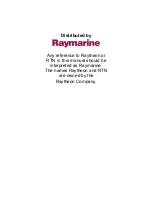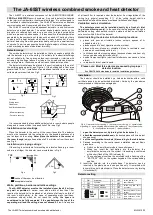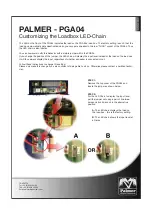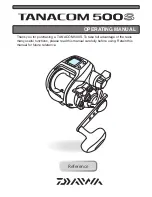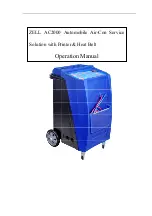
1. Malfunction or damage resulting from repairs made by personnel not authorized by J. MORITA MFG. CORP.
2. Any unauthorized modifi cations to its products
3. Malfunction or damage resulting from maintenance or repairs carried out using parts or components other than those specifi ed
by J. MORITA MFG. CORP.
4. Malfunction of or damage to MORITA products caused by products made by other manufacturers unless they were supplied by
J. MORITA MFG. CORP.
5. Malfunction or damage resulting from failure to observe the safety precautions or operating procedures described in these
Operating Instructions
6. Malfunction or damage resulting from ambient conditions that do not conform to the operating conditions specifi ed in these
Operating Instructions, such as an improper electrical power supply or installation environment
7. Malfunction or damage resulting from a natural disaster, such as a fi re, earthquake, fl ood or lightning
* Replacement parts and consumable parts are described in the Regular Inspection List. Replace parts as necessary based on the
degree of wear and length of use.
* Motor usage and handling: Read all instruction materials thoroughly before use and follow all cautionary remarks and usage
instructions.
J. MORITA MFG. CORP. maintains supplies of service parts for 10 years after discontinuation of their production.
For the duration of this period, we will supply replacement parts and be able to repair the product.
J. MORITA MFG. CORP. will not be responsible for the following matters, even during the warranty period.
Disclaimer
The user (e.g., healthcare facility, hospital, clinic, etc.) is responsible for supervising the use and maintenance of medical
devices.
This instrument must not be used by anyone other than a dentist, doctor or other legally qualifi ed professional.
This instrument must not be used for any purpose other than the provision of dental treatment.
Federal law restricts this device to sale by or on the order of a dentist (for U.S.A.).
Standards and Procedures for the Disposal of Medical Devices
If there is a possibility that a medical device is contaminated, the dentist or doctor responsible for the patient's treatment must
confi rm that it is uncontaminated, and must then have it disposed of by a healthcare facility or an agent licensed and qualifi ed to
handle standard industrial waste and industrial waste requiring special treatment.
The following symbols and expressions indicate the degree of danger and harm that could result from ignoring the instructions
they accompany:
This warns the user of the possibility of serious injury or death to the patient, damage or complete
destruction of the instrument or other valuable property, and fi re.
This warns the user of the possibility of slight or moderate injury to the patient.
This alerts the user of important points concerning operation of the instrument or the risk of dam-
age to it.
* Do not expose the handpiece to direct sunlight for an extended period of time.
* If the handpiece will not be used for an extended period of time, store it in a clean, dry place after autoclaving it.
* The useful life of the TORQTECH is 7 years (based on self-certifi cation) from the date of shipment provided it is
regularly and properly inspected and maintained.
Operating, Transport and Storage Environments
Maintenance and Inspection
* This instrument should be inspected every 3 months in accordance with the inspection items listed below.
* Maintenance and inspection are generally consider to be the duty and obligation of the user, but if, for some reason, the user is
unable to carry out these duties, he may rely on a qualifi ed medical device serviceman. Contact your local dealer or J. MORITA
OFFICE for details. Inspect the following items: 1. Motor connection. 2. Bur and point insertion. 3. Handpiece rotation, spray
and light. 4. Overheating.
* For repairs, contact your local dealer or J. MORITA OFFICE.
Service and Contacts
TORQTECH may be repaired and serviced by
For repairs or other types of service, contact your local dealer or J. MORITA OFFICE.
•
The technicians of J. MORITA's subsidiaries all over the world.
•
Technicians employed by authorized J. MORITA dealers and specially trained by J. MORITA.
•
Independent technicians specially trained and authorized by J. MORITA.
• Wear safety glasses to prevent injury to your eyes.
• Never switch rotation direction from forward to reverse or vice versa while the motor is actually running.
• Remove burs and points before returning the handpiece to its holder in the dental treatment unit;
otherwise, there is a risk of injury or damage.
• Do not press the push button until the handpiece has come to a complete stop; otherwise, the back
of the button could wear out and a bur could accidentally come out.
• Crown removal and other similar operations produce considerable vibration and can cause the bur to
get stuck in the handpiece. Avoid this by frequently taking the bur out and putting it back in again. If
a bur gets stuck, do not try to take it out with a pair of pliers or other forceful means; this could dam-
age the chuck and create a risk of a bur coming out during operation. Contact J. MORITA OFFICE
and have the handpiece repaired.
• If the handpiece makes abnormal noise or vibrates too much take out the bur or point, and replace it
with a new one. If the same problem persists, have the handpiece repaired.
• Follow all recommendations of the bur manufacturer concerning bur rotation speed and direction.
Warnings and Cautions
Parts Identifi cation
Accessories
Screw
Joint
Light Guide
Cap
Symbols
* The TORQTECH is not sterilized before shipping. It must be autoclaved before it is used for the fi rst time.
• Cap, body and screw tightness
• No gap between cap and head
• Light guide is not chipped, cracked or sticking out
• No conspicuous corrosion around the chuck opening
• No dirt or scratches etc. on the joint
• No bent or deformed components
• Motor connects properly and securely. Motor runs smoothly when foot
control is depressed. Spray is emitted normally. No air or water leakage
from motor joint. No abnoraml noise or vibration. Head, push button and
cap do not overheat.
1. Before Use
Push the handpiece straight onto the motor’s connection cylinder until
you hear it snap into place. (The light will not turn on at this time.) If
it has a light, turn the handpiece until the projection on it lines up with
the notch in the motor. There will be a click when the projection and
notch line up.
* Refer to the user manual for the motor.
* Make sure the O-rings on the motor’s connection cylinder are OK.
Do not connect the handpiece to a motor that rotates faster than 40,000 rpm.
Check that there is no dust or other debris on the motor's connection cylinder. The handpiece might malfunction if
there is.
Do not expose the handpiece to strong physical shocks such as by dropping it or swinging it against the dental
treatment unit when it is connect to its tube. This could cause it to malfunction or damage the light guide.
Light-equipped handpiece cannot be connected to a motor that does not have a light.
• Give the handpiece a light tug before using it to make sure it is securely connected.
• Wait for the motor to come to a complete stop before connecting or disconnecting the handpiece.
• Do not use any type of motor other than it conforms to ISO 14457.
2. Motor Connection
Pre-use inspection: Check for the following before using the handpiece.
Projection
Notch
If an abnormality is found, refrain from using the handpiece and have it pro-
fessionally repaired.
Make sure cap is not loose.
Make sure this
screw is in place
and tightened up
properly.
Cap
• Never use the types of burs or points described below. Using such burs or points is extremely dangerous
as they may become detached and cause injury to the patient's oral cavity or be swallowed by the patient.
*1 If any bur detergent, dust, or other foreign matter enters the chuck, contact your local dealer or J. MORITA
OFFICE to request an inspection.
[Specifi cations may be changed without notice due to improvements.]
2018-05-21 Pub.: L102-62001-501
Operation 1/2
• In cases of tooth extractions, split teeth, endodontic treatment etc. or incision or open wounds in
soft tissue, care must be taken that air emitted from the handpiece does not cause a subcutaneous
emphysema.
• Always use with spray water; otherwise the head, push button or cap could overheat and cause a burn.
• Never use the handpiece with no or too little cooling air; this could cause it to heat up and possibly
burn the doctor’s hand or the patient’s mouth.
• Do not use the handpiece if the head, push button or cap get too hot. The whole handpiece could
heat up and burn your fi ngers. The moving parts are probably malfunctioning and you should have
the handpiece repaired immediately.
• If a bur wobbles, take it out and replace it with new one. If the new one also wobbles, the head,
push button or cap could overheat. Stop using the attachment immediately and have it repaired.
• Operate the handpiece outside the oral cavity before use and make sure that burs or points do
not wobble, that there is no abnormal noise or vibration, that the head, push button or cap do not
overheat, and that rotation speed, direction etc. are normal. If something is wrong, do not use the
handpiece and have it repaired.
• If a bur or point comes out during use, stop using the handpiece immediately and have the hand-
piece repaired.
• Never use a bur or point to pull up on a metal crown or other metal piece. This is very dangerous;
the bur or point could come out and injure the patient or be swallowed.
• Always use spray and a soft (feather), intermittent touch to avoid injury to the pulp.
• Wait for the bur to stop rotating before taking the handpiece out of the oral cavity.
• To avoid cutting your fi nger etc., wait until the handpiece has completely stopped rotating before
inserting or removing a bur or point.
• Do not try to force the handpiece into a space if the patient cannot open their mouth wide enough.
You might inadvertently press the push button up against the teeth opposite the working area, es-
pecially in molar regions. If the push button is pressed during rotation, the head, push button or cap
could overheat and damage the pulp of the teeth opposite the treatment area or the instrument
might burn the inside of the oral cavity or the dentist’s fi ngers.
• If the handpiece is used with defective bearings or other moving parts, the head, push button or
cap could overheat and cause a burn. Do not use the handpiece if rotation speed is too slow or
produces any unusual vibration.
DC
• Do not use if cap, body or screw is loose.
• If the cap is loose, worn, or damaged, it could come off inside the oral cavity.
• Do not use the handpiece if the head or body is bent, warped or otherwise deformed or damaged.
Geared Contra Angle Handpiece Attachment
CA-DC(-O)
Operation Instructions
TORQTECH
Specifi cations
Geared Contra Angle Handpiece Attachment
Type
CA-DC-O
CA-DC
Light
Yes
No
Rotation Speed Ratio
1 : 1
Maximum Motor Speed [rpm]
42,000
Length [mm]
94
Weight [g]
67
Usable Burs
*1
Shank Type 1 (CA)
Chuck Type
Push Button
Cooling Air Flow [NL/min]
Minimum 6 (from motor)
Spray Flow [ml/min]
Minimum 50 (for 0.2 MPa instrument pressure)
Tip Air Flow [L/min]
Minimum 1.5 (for 0.2 MPa instrument pressure)
Connection Type
Conforms to ISO 3964 and DIN 13940
Connectable Motors
Conforms to ISO 14457
Usable Bur Length [mm]
12
Usable Bur Diameter [mm]
2.334–2.350
Maximum Bur Length [mm]
34
Maximum Working Area Diameter [mm]
4
Always use burs and points with clean shanks; dirty shanks cause the chuck to wear out more quickly and
lose its gripping power.
Some bur detergents contain components that cause metals to rust. Be sure to wash away the bur deter-
gent before inserting a bur or point into the chuck.
Diamond points are easily bent. Even new burs and points are sometimes poorly balanced: if a bur makes
a loud, metallic noise during rotation, stop using it.
Use burs that conform to ISO 1797-1
*1
Those which do not conform to ISO standards. Those with scratched or bent heads or shanks. Those
which are rusty, chipped or broken. Those which have been modifi ed or altered such as those having
shortened shanks.
• When using welded or blazed burs or points, ensure that the bur tip does not wobble.
(Autoclavable)
(Ethanol disinfectable)
* For parts that wear out and need periodic replacement,
refer to the Inspection Items and replace parts when-
ever necessary.
Head
Push Button
Identifi cation Ring
(Blue: 1:1)
Operating Temperature: +10°C to +40°C (+50°F to +104°F); Humidity: 30% to 75% (without condensation);
Atmospheric Pressure: 70 kPa to 106 kPa
Transport and Storage Temperature: -10°C to +70°C (+14°F to +158°F); Humidity: 10% to 85% (without condensation);
Atmospheric pressure: 70 kPa to 106 kPa
Spray Nozzle
Code No. 5071343
Spray Hole Wire
Code No. 5250940
Atmospheric pressure
limitation
GS1 DataMatrix
CE(0197) marking
Conforms with the European
Directive, 93/42/EEC.
CE marking
Conforms with the European
Directive, 2011/65/EU.
EU Authorized
Representative under the
European Directive 93/42/
EEC
Autoclavable up to 135°C
(275°F)
Supports high-temperature
cleaning and disinfection.
Manufacturer
Date of manufacture
Temperature limitation
Refer to instructions for
use
Humidity limitation
Serial Number
E.g., G00001
E.g., L102G00001K
Year of Manufacture
(G: 2018, H: 2019...)
1
1
1
Sold separately
LS SPRAY
Code No.7927568 or 5071340
MORITA MULTI SPRAY
Code No.7914113 or 5010201
(Ethanol disinfectable)
[Some symbols may not be used.]
Use this instrument with dental treatment units that conform to IEC 60601-1.
Thank you for purchasing a TORQTECH geared contra angle motor handpiece attachment.
This instrument is intended for drilling and polishing teeth and dental prosthetics. For optimum performance,
effi ciency, avoiding hazards, preventing patient injury, and safety, read the instruction maul thoroughly before use,
and follow all cautionary remarks and usage instructions.
Keep this manual in a handy place for ready reference.






